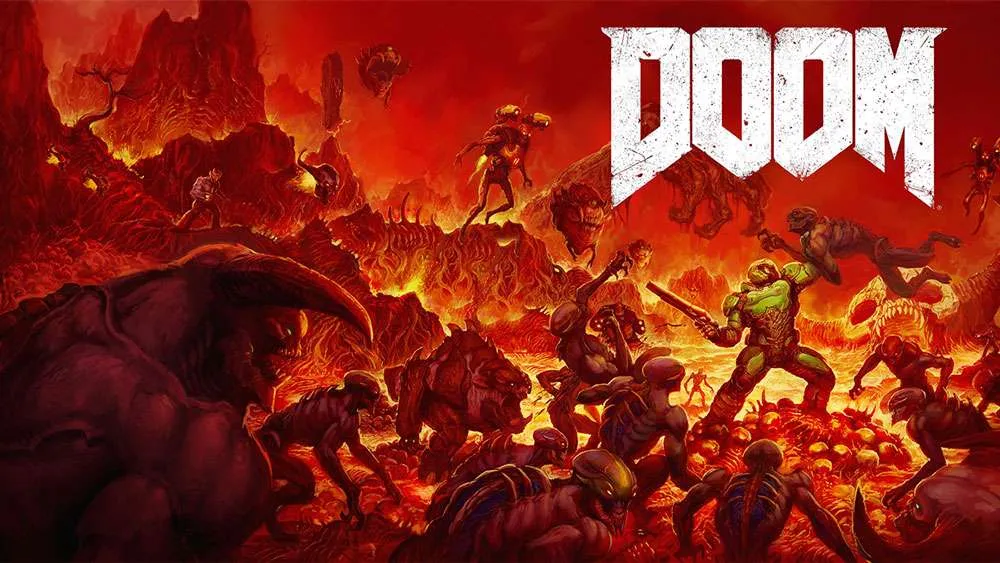
Doom (2016) is the first full-fledged Doom game since Doom 3 came out on PC and Xbox way back in 2004. That’s a twelve-year gap with only an expansion pack, a visually-upgraded re-release of Doom 3, and a mobile game. And as it turns out, Doom (2016) – hereafter referred to as “Doom” – is actually the second iteration of the game after the original Doom 4 concept was scrapped. The result is a reboot that makes the franchise relevant to a whole new generation of gamers.
The first thing that you notice about Doom is that this is not a game that takes itself too seriously. That’s a good thing, in my book, considering the history of the franchise. This is a game, after all, where you kill demons with an assortment of super violent weapons ranging from a shotgun to a chainsaw. Yeah, this game is gory, and that’s the point. Doom is unapologetic about being true to form with its roots firmly planted in 1990s video game culture. It makes no illusions that this is real life.

That is not the only nod, of course, to longtime fans. The developers allow you to play with both a modern off-center weapon and a “Doom Classic” weapon pose where the gun is at the center of the screen. It’s a nice nostalgic touch without compromising the quality of gameplay with an antiquated control system. It works and works well.
You start the game equipped with a standard pistol stocked with unlimited ammo. Along the way, you will pick up and keep new weapons. Some of the favorites are back like the aforementioned shotgun, chain gun, and rocket launcher. There are is also a Gauss cannon, a heavy assault rifle, and the fan-favorite BFG. Oh, and did I mention that the chainsaw is back?
All of these weapons have modifications that you can find scattered throughout the game. These mods allow you to add things like a scope to the assault rifle and the ability to preemptively spin the chain gun without firing a shot. Skill points earned from a level’s challenges, along with killing as many demons as possible, allow you to upgrade your weapons with even more abilities, such as quicker cooldowns.

The campaign in Doom progresses through a relatively linear set of events set off with a fair amount of large and fairly open spaces, as well as cramp close quarters combat and smaller arena-style areas. The reboot’s labyrinthine level design also takes cues from the original Doom with a modest amount of exploration to locate hidden areas and objects. Just like in classic Doom, you need to collect ammo, health packs, armor, and keys (both blue and yellow).
Enemy demons are varied in size, strength, and ability. You have garden variety zombie-like creatures, a fire-throwing demon, a monstrous tank of a demon who hunts you down, demons that spew acid, demons that launch at you like projectiles, and ones that are equipped with rocket launchers. These are just some of the enemies that you will face in your battle against the creatures of the underworld. And then there are, of course, a number of boss fights to keep you on your toes, just in case you start to get too cocky.
When they are near death, demons start to flash. You can either finish them off with a gun, grenade, environmental damage, or fatalities that the developers at id Software call glory kills. These glory kills often result in small boosts to your character’s health, although the health boost varies depending on how formidable the enemy is that you vanquish with more difficult enemies granting you more health.
Doom has a number of hidden areas and side content. Rune Trials are basically short, timed challenges that reward you with different abilities if completed successfully. The challenge may be to destroy all barrels, kill all enemies, or collect all objects within a specific period of time with the length often being extended for each barrel destroyed, enemy killed, or item collected.
Other modes include the Arcade Mode, SnapMap, and a multiplayer mode. The Arcade Mode basically is a scored time trial with leaderboards. SnapMap is a relatively simple-to-use but extensive game and level editor where you can also try out fan-made modes and maps.

The multiplayer feels a lot like a shooter from the late 1990s or early 2000s. Similar to the single-player campaign, the multiplayer maps also have an arena-like feel to them with frenetic close quarters combat. The closest analogy is Quake or Unreal Tournament. While I did not play a ton of it, the community seems to be pretty dead at this point. It is all right in short bursts, and playing as a demon is admittedly cool, but I cannot honestly see myself coming back for more.
That being said, Doom does have a fair amount of replay value. There are five different difficulty settings with varying number of enemies, enemy strength, damage, and the amount of ammo depending on the difficult setting. I could easily see myself playing the campaign a second time through on a harder difficulty, and I’ve already put in a number of hours replaying levels in Arcade Mode just trying to get a high score and finish as quickly as possible.
Now that Doom is in the bargain bin, it’s basically a must buy for fans of shooters. It manages to be both loyal to its source material while still being relevant for younger gamers accustomed to more forgiving shooters. This game does not try to be Call of Duty or Destiny. It is Doom through and through, and that’s why I love it.
